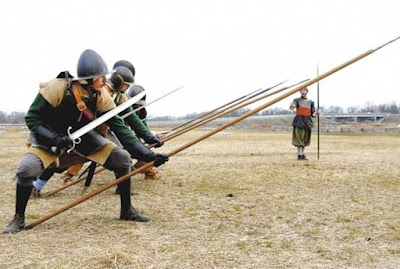or "differentiating weapons when all of them deal the same damage"
I also feel that the equivalent of health points (hits) are very high for starting characters. A fighter for example starts with 10 hits, which is equivalent to a "level five" monster.
from the hireling section
As I never understood the "all weapons are equal" approach I made some differentiations myself:
Daggers: Fighters do not add +1 when using daggers. This makes them a little worse than swords for them, but gives all the other classes a good reason to carry them (the usefulness of any weapon for the minimum encumbrance!). If you are attacking a grappled enemy, you can attack him an extra time per turn with the dagger.
Swords: Using an one-handed sword with two hands allows you to re-roll an attack once per combat. +1 against enemies classified as large (I saw this somewhere and felt good- not sure of where!)
Maces: On a roll of 12+ deal an extra hit. This makes them stastically good against heavy armors. One handed axes can fit here maybe. Crossbows also use this one when compared to bows, though the former take a turn to reload.
2-handed swords/axes: an extra hit on any succesful attack, just as RAW.
Spears: This one is a little more complicated. Or is it not? You get +1 AC to represent the biggest reach. This benefit is not cumulative with plate armor (to prevent AC bloat) and is negated as soon as you are hit, because you enemy has closed the range on you. If your enemy is that close to you, you must spend one turn to disengage or else they are too close to use the spear against them. If you do, you also recover that extra +1 AC.
Used with a shield, you're harder to hit, so this bonus might last longer. But the fighters only get their +1 when using it two-handed.
On special cases such as charging on a horse, or bracing against a charge, you get the +1 independently of wearing a shield or not, and all damage is doubled.
I've been watching a lot of HEMA fights lately, something that always puts me in a "weapon differentiation" mood, and I am very proud of this rule. I wanted something situational, that didn't put it over or under other weapons, and that represented the fact that when the enemy is over you, you better drop the spear and unsheathe a sword or a dagger, as modern fighters claim. In fact I liked this rule so much that I will port it to my normal game rules (both the current and the old d6 one. I like that variant to much to forget it)



Could the bonus for swords against large enemies be from AD&D? Both editions of AD&D had separate weapon damage tables for normal sized and large enemies, and swords (especially 2H swords) were always good against large enemies.
ReplyDeleteYou're right. And also in Greyhawk supplement. It also boosts polearms and spears set to charge
ReplyDeleteThe ruleset of P&P is relativelly light but classifies monsters by size, so when houseruling I wanted to take advantage on what the game already had
ReplyDelete